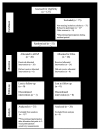Clinical Efficacy in Relieving Dentin Hypersensitivity of Nanohydroxyapatite-containing Cream: A Randomized Controlled Trial
- PMID: 30288181
- PMCID: PMC6142669
- DOI: 10.2174/1874210601812010572
Clinical Efficacy in Relieving Dentin Hypersensitivity of Nanohydroxyapatite-containing Cream: A Randomized Controlled Trial
Abstract
Objective: The study aimed to investigate the effectiveness of Apadent Pro (Sangi) Nanohydroxyapatite (nHAP) dental cream to relieve Dentin Hypersensitivity (DHS), compared with a positive control cream containing 20% pure silica (Silica).
Methods: In this double-blind, randomized, parallel-group clinical trial, patients diagnosed with DHS and qualified to participate were randomized into two groups, nHAP (n=25) and Silica (n=26). Subjects' baseline and posttreatment sensitivity were assessed using two pain scales, a four-point Dental Pain Scale (DPS) followed by a linear Visual Analog Scale (VAS), after the application of ice-cold and air stimuli. Subjects used custom-fabricated trays to apply their respective cream for 5 minutes once daily following brushing with standard fluoride toothpaste. Posttreatment sensitivity (efficacy) was assessed every 2 weeks for 8 weeks. Mean treatment outcomes (percentage change from baseline) at each time point were compared using the Tukey HSD test for multiplicity (P<0.05).
Results: With either air or cold stimulus, VAS and DPS indicated a significant (P<0.001) reduction in DHS at each time point with either nHAP or Silica. Comparing pain scales, VAS showed no significant difference in DHS reduction between the products with either air or cold. However, with DPS, DHS reduction was significantly (P<0.05) better with Silica than with nHAP at all time points with cold, and at 2, 4, and 8 weeks with air.
Conclusion: Both Apadent Pro nHAP and Silica dental creams are effective at promoting the relief of DHS symptoms. When comparing the efficacy of the two compounds to relieve DHS, results of the two pain scales were conflicting.
Keywords: Dentifrice; Dentin hypersensitivity; Dentin tubules; Nanohydroxyapatite; Silica; Tubule occlusion.
Figures
Similar articles
-
Clinical efficacy of nanohydroxyapatite-containing toothpaste at relieving dentin hypersensitivity: an 8 weeks randomized control trial.BDJ Open. 2021 Jun 25;7(1):23. doi: 10.1038/s41405-021-00080-7. BDJ Open. 2021. PMID: 34172718 Free PMC article.
-
A comparative clinical study investigating the efficacy of a dentifrice containing 8% strontium acetate and 1040 ppm fluoride in a silica base and a control dentifrice containing 1450 ppm fluoride in a silica base to provide immediate relief of dentin hypersensitivity.J Clin Dent. 2010;21(2):42-8. J Clin Dent. 2010. PMID: 20669815 Clinical Trial.
-
Clinical efficacy in reducing dentin hypersensitivity of a dentifrice containing 8.0% arginine, calcium carbonate, and 1450 ppm fluoride compared to a dentifrice containing 8% strontium acetate and 1040 ppm fluoride under consumer usage conditions before and after switch-over.J Clin Dent. 2011;22(4):128-38. J Clin Dent. 2011. PMID: 22403989 Clinical Trial.
-
Dentin hypersensitivity: from diagnosis to a breakthrough therapy for everyday sensitivity relief.J Clin Dent. 2009;20(1):1-9. J Clin Dent. 2009. PMID: 19489186 Review.
-
Recent advances in dentin hypersensitivity: clinically proven treatments for instant and lasting sensitivity relief.Am J Dent. 2010 May;23 Spec No A:3A-13A. Am J Dent. 2010. PMID: 21284246 Review.
Cited by
-
Clinical efficacy of nanohydroxyapatite-containing toothpaste at relieving dentin hypersensitivity: an 8 weeks randomized control trial.BDJ Open. 2021 Jun 25;7(1):23. doi: 10.1038/s41405-021-00080-7. BDJ Open. 2021. PMID: 34172718 Free PMC article.
-
Role of Nanotechnology in Dentistry: Systematic Review.J Int Soc Prev Community Dent. 2019 Nov 4;9(6):535-541. doi: 10.4103/jispcd.JISPCD_223_19. eCollection 2019 Nov-Dec. J Int Soc Prev Community Dent. 2019. PMID: 32039072 Free PMC article. Review.
-
The Effectiveness of Calcium Phosphates in the Treatment of Dentinal Hypersensitivity: A Systematic Review.Bioengineering (Basel). 2023 Apr 6;10(4):447. doi: 10.3390/bioengineering10040447. Bioengineering (Basel). 2023. PMID: 37106634 Free PMC article. Review.
-
Nano-Hydroxyapatite (nHAp) in the Remineralization of Early Dental Caries: A Scoping Review.Int J Environ Res Public Health. 2022 May 5;19(9):5629. doi: 10.3390/ijerph19095629. Int J Environ Res Public Health. 2022. PMID: 35565022 Free PMC article.
-
Nanohydroxyapatite in dentistry: A comprehensive review.Saudi Dent J. 2023 Sep;35(6):741-752. doi: 10.1016/j.sdentj.2023.05.018. Epub 2023 Jun 7. Saudi Dent J. 2023. PMID: 37817794 Free PMC article.
References
-
- Canadian advisory board on dentin hypersensitivity Consensus-based recommendations for the diagnosis and management of dentin hypersensitivity. J. Can. Dent. Assoc. 2003;69(4):221–226. - PubMed
-
- Cartwright R.B. Dentinal hypersensitivity: A narrative review. Community Dent. Health. 2014;31(1):15–20. - PubMed
Grants and funding
LinkOut - more resources
Full Text Sources





